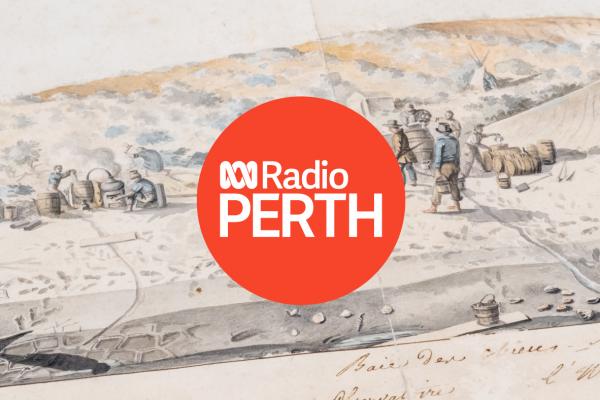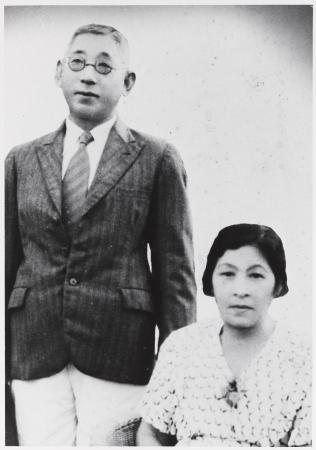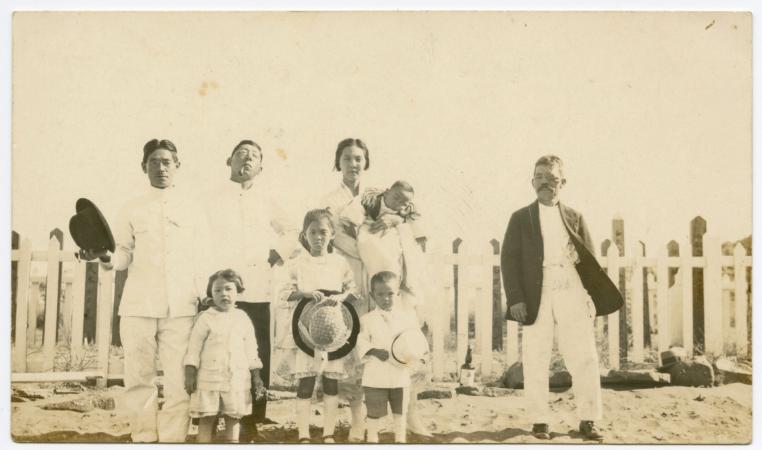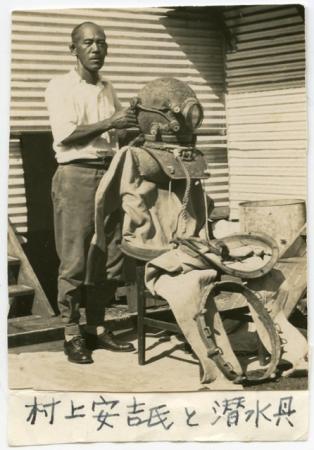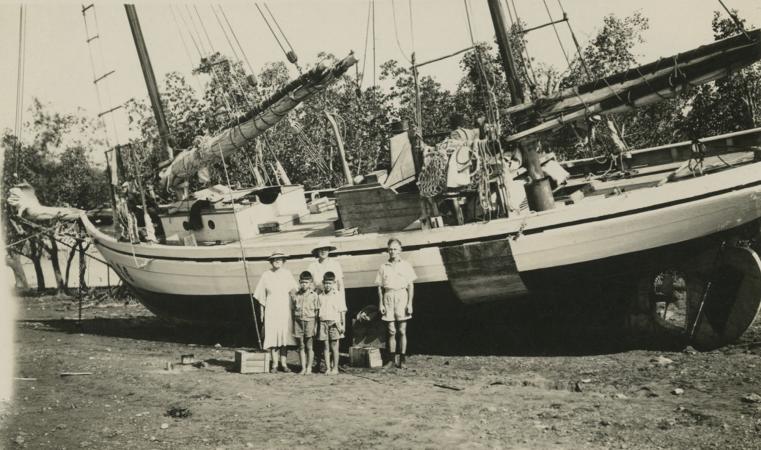The State Library has a very special collection of business ledgers from J&T Muramats, a business that operated in Cossack from 1891 prospering through the early twentieth century until the outbreak of the Pacific War in 1942.
Join Dr Kate as she shares the incredible story of Jiro Muramats, his importing merchant business and his pearling ventures and role within the Cossack community. These ledgers were discovered in Japan and in May 2022 were donated to the State Library. They are fully digitised and accessible online through the State Library catalogue.
Recorded live on ABC Radio Perth on 5 May 2023.
Transcript
Beginning of Transcript
Sam Longley: On the long lunch! ABC Radio Perth and WA.
So today we're looking at a very special collection of business ledgers that were discovered in Japan only last year. They've since travelled all the way to WA after being donated to our State Library as another piece of the puzzle that was already being collected.
The ledgers are from J. & T. Muramats, a business that operated from Cossack in 1891. Have you ever been to Cossack? I have...I did...yeah, well...It was prospering through the early 20th century until the outbreak of the Pacific War in 1942. The ledgers give us a better understanding into Jiro Muramats and his wife Hatsu, their life in Cossack, Darwin and their maintenance of relationships in Japan over several decades and I have Dr Kate Gregory, Battye historian at the State Library of WA, and she is in the studio with us now. How are you doing, Dr Kate?
Kate Gregory: I’m well, Sam, how are you?
Sam Longley: I’m very well. I am really intrigued because when you have certain parts of a puzzle and there's one chunk missing, it is both the most exhilarating thing because you're on the edge of can I find it and it's also the most devastating, it's just not complete.
Kate Gregory: Ah…welcome to the life of an archivist!
Sam Longley: [Laughs].
Kate Gregory: It's never complete. I think in our case, I mean, it was a really great analogy but there are still many pieces of the puzzle to be filled in about the Muramats’ business and the Japanese life in Cossack and in the northwest, but this is so tremendously exciting to find out about these business ledgers, that still existed and effectively document a period of time really 50, 60 years from the late 1800s right through to the outbreak of the Pacific War as you said, so it's a tremendously exciting acquisition…
Sam Longley: Mmm...
Kate Gregory: ...for the State Library.
Sam Longley: And do we know where and how these ledgers were discovered? Did somebody just go through a bookshelf and go "Oh...the State Library of WA will want these!"
Kate Gregory: Well, I mean sort of...what happened was that back in 2020 I think it was, I got this sort of email out of the blue from a Japanese scholar based in Japan by the name of Mayumi Kumada and she had been researching the influence and the role of the Japanese community in Australia and she’d struck upon the story of Jiro Muramats and had been researching and contacting a number of colleagues located in Australia and in Japan trying to piece together the story of this Muramats’ business so she contacted me and we started corresponding - and then…this is COVID so she had planned to come out but she couldn't come and then eventually as soon as the borders opened, she came and she met with some of her colleagues and they went up to Cossack and they've been researching the life of Jiro and his wife Hatsu; and in amongst that discussion taking place, she actually discovered these ledgers that were still held by family members in Japan, and at that point...it was very exciting, she had them digitised and then they finally, the physical business ledgers, actually arrived at the State Library last year and yeah again…they're fragmentary - there are five ledgers so there would have been more. But they're all so hefty, they're big books.
Sam Longley: Yeah.
Kate Gregory: Big documents. I actually had a look at them this morning.
Sam Longley: Oh wow!
Kate Gregory: And it was very exciting and partly because when they arrived, we discovered that some of them were very badly affected by mould
Sam Longley: Oh yeah.
Kate Gregory: And what happens in that instance, is they need to be put into deep freeze.
Sam Longley: Do you freeze mould?
Kate Gregory: Freeze the mould to halt the deterioration and the process of mould, kind of eating away at the papers - so they've been in the freezer [laughs] at the State Library! Look it was very exciting.
Sam Longley: Yeah.
Kate Gregory: This morning I went to the freezer [laughs] I saw these big ledgers, business ledgers...so yeah look...that was very interesting that’s preventative conservation - and the conservation practice in process. But effectively shall I tell you a little bit about...
Sam Longley: Yeah look...I would really like to know about Jiro Muramats. Have I said that right? Jiro Muramats.
Kate Gregory: [Laughs] Jiro Muramats. I believe so.
Sam Longley: I do want to know what's in the State Library freezer apart from ledgers. Is there State Library ice cream?
Kate Gregory: [Laughs].
Sam Longley: From 1912? I don't know.
Kate Gregory: [Laughs].
Sam Longley: But let's talk about Jiro Muramats.
Kate Gregory: Yeah
Sam Longley: What do we know of his life?
Kate Gregory: That's right, so look he was born in Japan in 1878 and his father actually came to Cossack in 1891 and look, that was at a time when Cossack was booming, it was thriving. Cossack had been first settled in 1863 and it was originally known as Tien Tsin and then its name was later changed to Cossack and I guess Cossack existed, it was the port that connected Roebourne and the sort of emerging pastoral stations around the Pilbara with the rest of the world. They had shipping routes straight to Singapore, so wool was the first export from Cossack but with the difficulties in, I guess, supporting a thriving wool industry, pearling was established as an industry and so the town of Cossack grew and grew and pearling was actually carried out at Cossack prior to Broome so it was the first centre for...pearling in Western Australia and...Muramats…
Sam Longley:...so we got wool going out and then we've got pearl shell and wool. It must have been a lucrative time.
Kate Gregory: It was, it was...and so precisely why Muramats’ father actually established a business in Cossack and he was a merchant and an importer. He ran a store in Cossack and it was a really kind of vital part of the Japanese association for Cossack which we've got the records that this association established and was established…in the late 1900s and we know from the archaeological evidence as well that there was a thriving Japanese community in Cossack.
Sam Longley: Uh huh.
Kate Gregory: There is a Japanese cemetery at Cossack.
Sam Longley: OK.
Kate Gregory: And Jiro's father is buried there. So that...the kind of multicultural connections that Cossack had with the rest of the world were really striking. It was a thriving multicultural town there were Japanese communities, Chinese communities, there were of course a lot of Ngarluma Yindjibarndi people who were used as forced labour within this context in pearling so it's quite a dark history, but within it all, the Muramats’ family business was thriving and Jiro actually came out to Australia and he'd been educated in Japan, and then interestingly, his father - he goes to a Jesuit school in Melbourne, a very well established Jesuit school called Xavier College and...so he was educated from age 17 to 19 in Melbourne and in the course of that time, he was obviously very very bright - he won all sorts of prizes...he learnt English fluently after really not speaking very much English when he first arrived, so he was a very very bright student.
Sam Longley: Yeah.
Kate Gregory: And then his father died and he went back to Cossack and despite being...he was the second eldest...so there was an older son, he actually took on the business and took on the running of this family business at that point and that was in 1898.
Sam Longley: We are talking with Dr Kate Gregory, the Battye historian at the State Library of WA. Jiro Mura…
Kate Gregory: Muramats.
Sam Longley: Muramats. But the father's Muramatsu.
Kate Gregory: Yeah.
Sam Longley: Is that a...
Kate Gregory: And that was one of the difficulties that the Japanese scholars kind of had because…so Muramats - he anglicised his name…
Sam Longley: Ah right as so many people did.
Kate Gregory: …and that's common.
Sam Longley: Yeah.
Kate Gregory: And I guess the other context to this whole story is about the White Australia policy and the various kind of legislation that...sort of instrumentalised that kind of White Australia focus which made it really difficult for Japanese businessmen like Jiro, but the interesting thing about Jiro is because he had this Melbourne education and he was very fluent and...very networked person, he actually was naturalised as a British subject prior to Federation.
Sam Longley: Right.
Kate Gregory: So doing that enabled him to purchase property, enabled him to purchase pearling licences, pearling luggers, and really develop his business within Cossack and that is precisely what he did. Many other Japanese people weren't naturalised of course and didn't have and weren't able to vote, weren't able to buy property, all sorts of other discrimination. But Jiro was able to do that and, in the lead up to World War I, that's exactly what he did - he got into pearling.
Sam Longley: Ahh.
Kate Gregory: Yeah.
Sam Longley: So he was a successful businessman. Is this why we still have those sort of records around and why this is an interesting puzzle or?
Kate Gregory: Yes, it is! I guess so...I mean he was interesting because…yes he was a successful business entrepreneur in Cossack in this period of time, but despite that his history has been largely forgotten...
Sam Longley: Yeah right.
Kate Gregory: And in fact the story of the Japanese role within the development of the northwest is definitely one that hasn't been very much documented and so that's why I think this current research into our existing collections but also the discovery of these new business ledgers is so important because it is helping to reclaim this previously largely forgotten history.
Sam Longley: Mmm...and what impact did the wars have on him, on Cossack, on everybody at that time? Well that's too broad a question, can’t ask you for everyone, but for Jiro.
Kate Gregory: Absolutely. So look, well with World War I what that did in particular was interrupt the pearling industry.
Sam Longley: Right.
Kate Gregory: So he had an...and it's interesting because at that time in the early 1900s, the pearl had actually been overfished, I think is the word, it seems wrong but overfished [laughs].
Sam Longley: But it did - they're a shellfish, you can fish them, you can farm them.
Kate Gregory: So that's right, they weren't farmed at this stage.
Sam Longley: No.
Kate Gregory: All diving or collecting, and so they were – they were literally collecting and diving quite deep. And Jiro was mainly employing Japanese indentured labour so yes - so the pearling industry actually was overfished within Cossack and that's when it went to Broome and Broome really flourished as a pearling centre, but Jiro continued to diversify his business interests. At that time he was still acquiring new pearling licences and also acquiring a lot of property. He acquired actually apparently about over half of Cossack, so he had acquired things like what's known now as the Customs House building. He ran a hotel. So, he really stitched up Cossack in some ways.
Sam Longley: He really did.
Kate Gregory: [Laughs] Yeah, and…but with World War I, the outbreak of World War I everything stopped and the pearling industry largely stopped so it was kind of put into a bit of hiatus. After World War I that kicks off again, and I mean part of what our documents show in the State Library is Jiro's communications through telegraph with these international pearling business networks and sort of trade companies. He was quite amazing so what he was doing, was liaising directly with New York through telegraph around the price of pearl for Cossack and then getting that pearl shell from Cossack directly to New York and to London to these...it was quite amazing so he…
Sam Longley: It is!
Kate Gregory: These international networks that were operating out of Cossack at this time in the post-war period…but so he continues on through the 20s and the 30s and is really pivotal I would say in a lot of the shipping and the business around Cossack and even Roebourne as well. He even gets into asbestos early on, so...he’s right in there across a number of streams of business; but of course with World War II, what we get is a lot of racism…
Sam Longley: Yeah.
Kate Gregory: …against Japanese people and in fact with the outbreak of the Pacific War at that time, then Japanese people in Australia are interned.
Sam Longley: Does he end up in an internment camp like so many people did?
Kate Gregory: That's right, and it's a very very sad end to this...incredible story really because Jiro and his wife Hatsu, were interned in Victoria and...they had gone on to have property in Darwin and be involved in the flourishing Darwin pearling industry as well, so he'd expanded. He had somebody else running his Cossack operations, also a Japanese man who was interned with Jiro and Hatsu in Victoria and both Jiro and his righthand man actually end up dying in internment so he doesn't survive that period of time. And at the end of the war, Hatsu survives but at the time as many Japanese internees, they were offered...she was offered to be repatriated to Japan but of course Hatsu had hardly spent any time in Japan at all.
Sam Longley: Right.
Kate Gregory: Although her daughter. They had one daughter, Jiro and Hatsu, who had largely been educated in Japan. She'd been sent back to Japan at the age of 6 from Cossack and educated by family.
Sam Longley: Wow. So dad goes to Melbourne, to Xavier College. And she goes to Japan.
Kate Gregory: Back to Japan and she is educated there. Hatsu at the end of her internment in Tatura internment camp in Victoria, decides to go back to Cossack. So she returns to Cossack and what she finds, is pretty much...I mean there's hardly anyone living there. She lives there throughout the 1950s, in fact she becomes known as the last resident of Cossack before it became...well no one lived there and it became, it more or less became a ghost town.
Sam Longley: Was she the last resident, do we know?
Kate Gregory: Yeah, I think so…and one of the last for sure and she ends up in 1957 there are letters sent by Hatsu back to her family in Japan and it's really sad because she spent a lifetime in Australia but she decides to go back to Japan where her daughter is, and with her we think she brought these ledgers because they'd been left in Cossack through the war. Because they’re massive, they’re huge.
Sam Longley: Yeah.
Kate Gregory: They would have been abandoned prior to the war before their internment.
Sam Longley: Yep, like I do with my tax. Yeah, I just leave it.
Kate Gregory: [Laughs] Left there. But she brings these back as the...last vestige of the business enterprise of Jiro and as a testament to his life for her daughter, and then all these decades later, this Japanese researcher then discovers these ledgers held by family descendants and they decide to very generously donate them to the State Library.
Sam Longley: Dr Kate. That is an incredible story. I love that one, that is amazing! Thank you so much for coming in and sharing this story with us. I'm going to have to send you back to the freezer now.
Kate Gregory: Yeah [laughs].
Sam Longley: Until we speak to you next time.
Kate Gregory: That's great, thank you, Sam.
Sam Longley: Thanks for your time, Dr Kate Gregory there, the Battye historian at the State Library of WA.
End of Transcript
You may be interested in...
